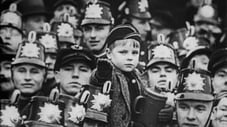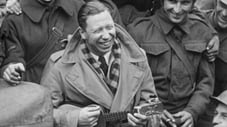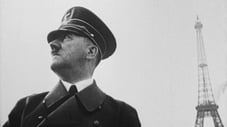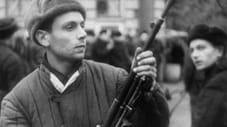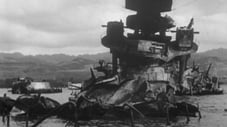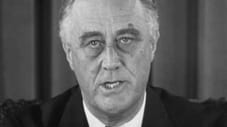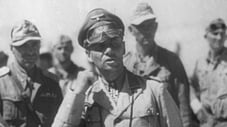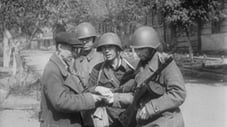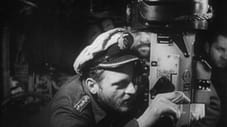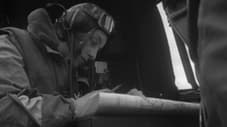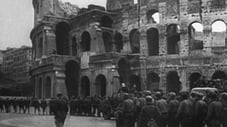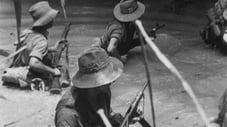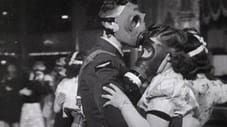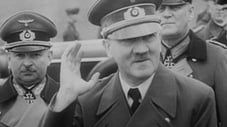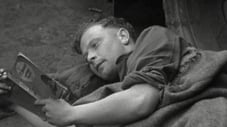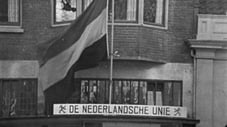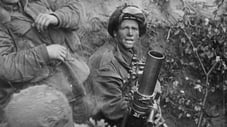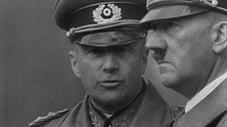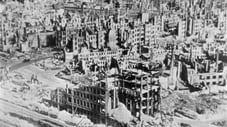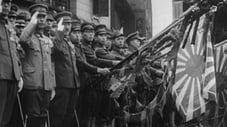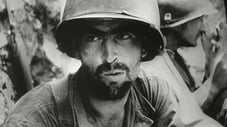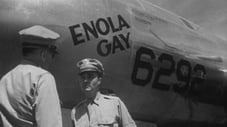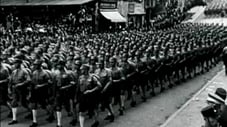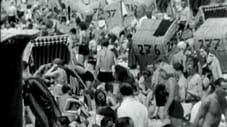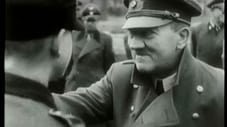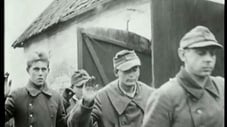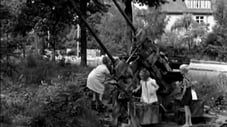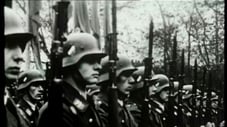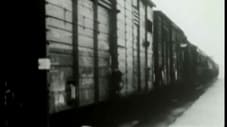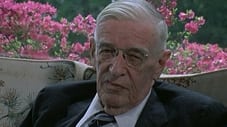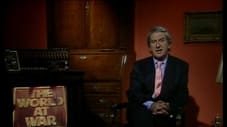
The World at War (1973)
← Back to main
Laurence Olivier as Narrator
Episodes 26
A New Germany (1933–1939)
Germany, a nation stricken by humiliating defeat and emerging from crippling economic depression, looks to one man for a resurgence of hope and dignity. That man is Adolf Hitler…
Read MoreDistant War (September 1939–May 1940)
In Eastern Europe, the full force of the Nazi machine rolls on - but in Britain, an uneasy calm settles on the nation. It is the 'phoney' war, with the sound of distant guns thundering ominously on the horizon…
Read MoreFrance Falls (May–June 1940)
France discovers it is woefully unprepared for modern warfare as the Nazi war machine easily skirts around the Maginot Line. Britain retreats and prepares for invasion.
Read MoreAlone (May 1940–May 1941)
After Dunkirk, Britain faces the German onslaught. Although the Rap wins the Battle of Britain, the cities are blitzed and on the continent the last Allies are conquered. The outlook is grim.
Read MoreBarbarossa (June–December 1941)
Hitler at last turns his tanks towards Russia. After a succession of devastating victories, the Germans delay and the fierce Russian winter takes a grip.
Read MoreBanzai! Japan (1931–1942)
At war since 1931 on the Chinese mainland, the Japanese hope for easy victories over the British and Dutch. And then on December 7th 1941, Japan makes their infamous attack on Pearl Harbour.
Read MoreOn Our Way: U.S.A. (1939–1942)
Americans are divided between fighting the Japanese and the Nazis. Hitler solves the problem by declaring war on the U.S.A.
Read MoreThe Desert: North Africa (1940–1943)
For 2 years the 8th Army and Rommel's Afrika Corps fight in the wastes of North Africa. Finally the tide turns at El Alamein.
Read MoreStalingrad (June 1942-February 1943)
Hitler's early successes in Russia made him reckless and he resolves to capture Stalingrad. The battle lasts six months with the Russians emerging as victors. The Wehrmacht never recovers.
Read MoreWolfpack: U-Boats in the Atlantic (1939–1944)
In a war of high technology and animal courage, the German U-Boats fight Allied merchantmen, hounding them in packs.
Read MoreRed Star: The Soviet Union (1941–1943)
For two years the Soviet Army fights the Germans almost alone. After one of the greatest land battles in history, the nation survives and triumphs - but with a loss of no less than twenty million of its people.
Read MoreWhirlwind: Bombing Germany (September 1939–April 1944)
Bomber Command begin bombing German cities by night and the Americans reinforce the attacks by day; a whirlwind of terror and destruction that will win the war.
Read MoreTough Old Gut: Italy (November 1942-June 1944)
Churchill called Italy the 'soft underbelly of the crocodile' and thought the Allies could cut through it to the heart of Germany. By the soft underbelly turned out to be a 'tough old gut'.
Read MoreIt's a Lovely Day Tomorrow: Burma (1942–1944)
Vera Lynn sang of a lovely day tomorrow, but the war in Burma was mud and monsoon. Britain's largest army learned to master the jungle and fought the Japanese to standstill.
Read MoreHome Fires: Britain (1940–1944)
Finding strength in unity at home in Britain during the war, it was a time of gas masks, Winston Churchill, Dig for Victory, evacuation, George Formby, the Land Army, ITMA, the Squander Bug and the Beveridge Report.
Read MoreInside the Reich: Germany (1940–1944)
Initial victory in Europe turns sour after the defeat at Stalingrad, yet Germany prepares to fight to the end - even after an assassination attempt on the Führer.
Read MoreMorning (June–August 1944)
The Western Allies resolve to invade Europe. England becomes a floating supply dump and the British and Americans assemble the largest invasion fleet in history. It is June 6th 1944 - D Day.
Read MoreOccupation: Holland (1940–1944)
Through a neutral country, Holland is attacked by Germany without warning in 1940. During the next four years, life carries on seemingly without incident, but underneath resistance never dies.
Read MorePincers (August 1944–March 1945)
The end of the war appears close at hand with the liberation of Paris in 1944, but the British and Americans disagree on how to advance. Meanwhile, Poland suffers devastating losses to achieve victory.
Read MoreGenocide (1941–1945)
The Nazi's are racist; the Aryans are a master race, others, particularly the Jews are sub-human. Himmler's SS sets about ridding Europe of millions of Jews.
Read MoreNemesis (February–May 1945)
Hitler retreats to the Fuhrer bunker is Berlin as Germany crumbles around him and his lieutenants abandon him to a fate of suicide. Meanwhile, the Russians raise the red flag in Berlin.
Read MoreJapan (1941–1945)
Initially apprehensive about the outcome of declaring war, the Japanese quickly turn to celebration with early victory. In the end, their worst fears are unimaginably exceeded.
Read MorePacific - The Island to Island War (February 1942–July 1945)
The Americans fight their way across the Pacific towards Japan and the Phillipines. Perhaps the bloodiest campaign of all, each island has to be taken by storm and the Japanese fight to the last man.
Read MoreThe Atomic Bomb (February–September 1945)
Western scientists have developed a new, immensely powerful weapon - the atomic bomb. On August 6th 1945, the Enola Gay delivers the world's first atomic bomb to Hiroshima. The world would be forever altered.
Read MoreReckoning (April 1945)
The war ends slowly and messily. Britain is victorious but exhausted and the super-powers confront each other as they decide the fate of Europe.
Read MoreThe Making of the Series
A fascinating behind-the-scenes look at the individuals, the technology, and the historical resources that made this examination of World War II such a powerful and unforgettable visual experience.
Read MoreHitler's Germany: The People's Community (1933 - 1939)
The harsh outcome of the First World War left Germany ripe for Adolf Hitler and his Nazi party's swift rise to power, promising a devastated nation's return to international prominence. See how the Germans worked, played and organised themselves for war as the Third Reich set the stage for the second world war.
Read MoreHitler's Germany: Total War (1939 - 1945)
Continuing the in-depth look at Hitler's regime through the lives of ordinary citizens, this special presentation shows how they coped with mass bombing, invasion and ultimately defeat.
Read MoreSecretary to Hitler
Traudl Junge found herself in Berlin during the war because she wanted to be a ballet dancer. A friend told her about a job vacancy in Hitler's chancellery; she applied for it and looking like Hitler's mistress Eva Braun, she became one of his private secretaries. Traudl Junge saw Hitler at close quarters, shared his public life and was with him in the bunker at the end.
Read MoreThe Two Deaths of Adolf Hitler
Years after his death, mystery still surrounds the circumstances under which Adolf Hitler ended his life. Did he die from a self-inflicted gunshot? Or did he swallow cyanide with his recent bride Eva Braun?
Read MoreWarrior: Reflections of Men at War
Reflections of men at war compiled from interviews and archive film obtained for The World at War series. A measured and decidedly unromantic look at the heat of battle, WARRIOR weaves together eyewitness accounts and rarely seen archive footage to reveal the deadly realities of combat.
Read MoreFrom War to Peace
Renowned historian Stephen Ambrose examines the aftermath of World War II. Was peace truly gained? Or did a new war with weapons of policy take its place?
Read MoreThe Final Solution: Part 1
Examining the growth of the Nazi racial doctrines from their origins to 1939, we see the terrifying and unforgettable stories as told by death camp survivors and also compelling interviews with German participants.
Read MoreThe Final Solution: Part 2
Archive photographs and shocking footage filmed by the Nazis themselves, capture the full horror of Germany's systematic extermination of millions of Jews and other non-Aryan civilians. Unflinching and often disturbing, this is a profound and necessary examination into the darkest corners of humanity.
Read MoreExperiences of War: Imperial War Museum Extended Interviews
Prominent scholars and military figures recount specifics of the war, from first hand accounts of Okinawa to the D-Day landing and analyze key wartime actions in these previously unseen and extended interviews taken from the archives at the Imperial War Museum.
Read MoreRestoring ‘The World at War’
A fascinating look at the incredible array of high tech wizardry which was used to upgrade this release. Anyone who may think any of the decisions with regard to this release, and its reframing in particular, were made cavalierly owes it to themselves to watch this really excellent piece. It makes it quite clear that everyone wanted this blu-ray to be an exceptional product, and no decision was taken lightly.
Read MoreHeaven and Hell
The Making of The World at War.
Read MoreAuschwitz Part 1
We don't have an overview translated in English. Help us expand our database by adding one.
Auschwitz Part 2
We don't have an overview translated in English. Help us expand our database by adding one.
Who Won World War II
We don't have an overview translated in English. Help us expand our database by adding one.
Outtakes and Extras - Part 1
We don't have an overview translated in English. Help us expand our database by adding one.
Outtakes and Extras - Part 2
We don't have an overview translated in English. Help us expand our database by adding one.
Restoring the World at War
the “Restoring The World at War” featurette shows how the documentary was treated with high-definition picture and surround sound to make the series stand out like never before. High-definition editors focused first on color grading and then high definition using a program called Archangel. The process was meticulous, and the way the documentary approaches the process is equally so.
Read MoreMaking the Series: A 30th Anniversary Retrospective
In this 2 hour 30th Anniversary retrospective, we commemorate the original 1973 broadcast with new interviews with the makers of the programme.
Read More